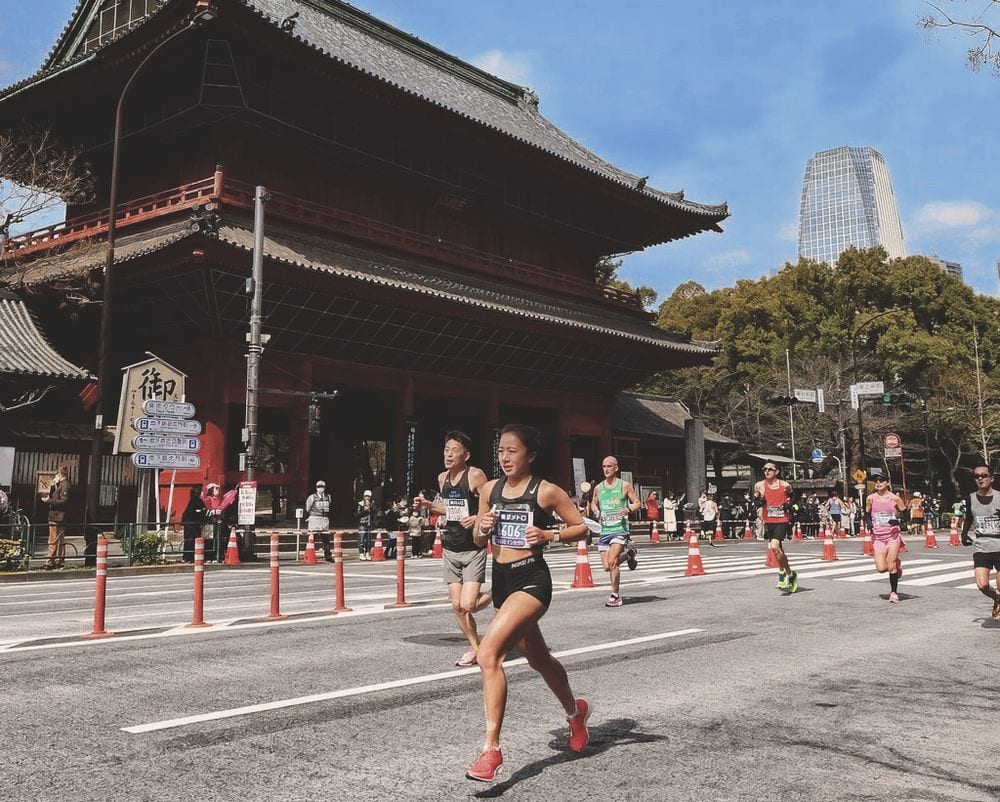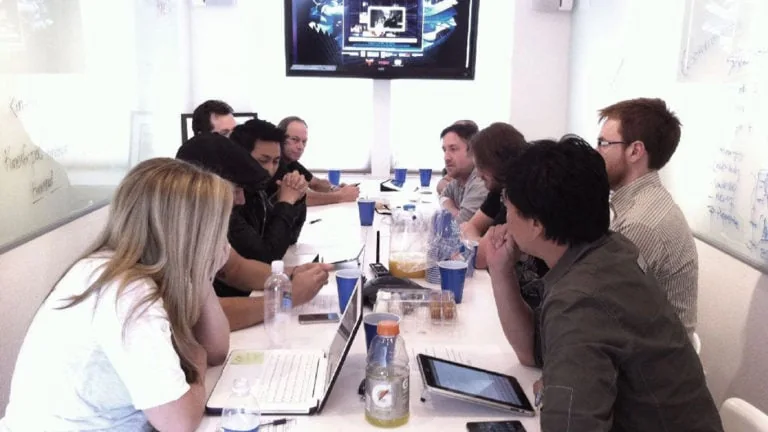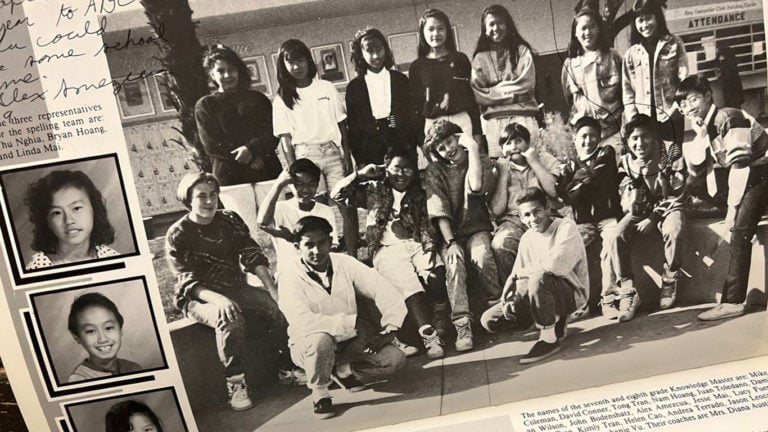Madeleine Nakada – A Runner’s Journey With Marathons
As dawn broke over Tokyo, Madeleine “Maddy” Nakada, a now competitive amateur runner at the age of 25, was steeling herself for the marathon ahead, an exhilarating yet formidable undertaking. The city was alive with the energy of thousands of runners, their breath hanging in the cold morning air. Madeline’s heart pounded in her chest, her nerves jangling at the icy chill that took her by surprise. Japanese runners swathed in full-body suits brushed past her, their preparedness a stark contrast to her feeling of being underdressed and out of sync. “Maybe I underestimated this,” she thought, her mind a whirlwind of anticipation and apprehension.
Despite the chaos, Maddy was not an inexperienced runner. She found herself placed in the first corral, the elite runners just a breath away. But this honor brought a new wave of anxiety. “Stay focused,” she silently urged herself, bracing for the onslaught as the starting pistol echoed through the crisp morning air. What lay ahead were moments of camaraderie and solitude, of triumph and despair. Little did she know, the Tokyo Marathon was about to test her endurance and determination in ways she had never anticipated, pushing her to the very limits of her physical and mental capacity.
The Spark of Running and Marathoning
Maddy, a native of San Francisco, was born with an uncanny knack for running that revealed itself in her early years. Her journey began in the third grade when her lack of coordination was blatantly obvious. Her well-meaning parents had tried to channel her boundless energy into various sports, but each attempt seemed to end in failure. Then came the mandated eight-minute run in her PE class, an exercise she surprisingly found herself reveling in.
From that point onward, running became a family affair. Every year, she would participate in 5K runs with her father. For the first couple of years, they ran side by side, but as her skills developed, her pace surpassed his, and she began to embark on these runs alone.
Her passion for running followed her into middle and high school, where she joined the cross-country teams. The schools were small, fostering a close-knit team atmosphere that only fueled her love for the sport. However, by the time high school graduation neared, Maddy was feeling the burnout. Having run between 10 and 40 races each year, she had accumulated a staggering number of races throughout her high school career.
In a surprising turn of events, she decided not to pursue running in college, not wanting her choice of institution to be dictated by her athletic pursuits. Her decision led her to an east coast college where her running continued, albeit in a more casual manner.
Running The First Marathons
Fast forward to 2018, on a whim, she decided to run her first marathon, the Baystate Marathon. Being under-trained, she wasn’t entirely unprepared. She had managed a 20-mile run in her training, despite her college life often reducing her daily runs to the bare minimum of a single mile, sometimes completed just before midnight on a treadmill. Her weekly mileage fluctuated between 30 and 50 miles, a reasonable base for a marathon, though not one she’d dare to tackle a marathon with today.
Despite the odds, she completed the marathon in 3 hours and 35 minutes, a feat that left her in disbelief. This pivotal moment marked her re-entry into the world of running, rekindling her passion that had been momentarily extinguished. She thought, “I knew that when I was a kid, I told myself, one day I’ll run a marathon, and now I’ve accomplished more than I ever set out to accomplish. Now, I think One day, I’m going to qualify for Boston,”
The realization that she could run such distances sparked a surge of ambition. She had achieved a childhood dream of running a marathon. Then later that year she went on to qualify for the prestigious Boston Marathon at just 21, crossing off a significant item from her bucket list much earlier than she had ever imagined. It was an accomplishment that prompted her to revisit and expand her aspirations.
Maddy’s senior year of college was thrown into chaos with the onset of the COVID-19 pandemic, disrupting her plans for life post-graduation along with her chances of running the illustrious Boston Marathon in the upcoming year. However, she swiftly adapted, embarking on a new career as a software engineer and relocating to the east coast. With restrictions in place and a limited range of activities available, she found solace in running.
Marathoning Post College
Her move back to New York coincided with the gradual reopening of the city, prompting her to join running clubs for the first time since high school. This marked a significant shift in her running experience. No longer was she competing against her peers; instead, they were all striving toward personal growth. She found a sense of camaraderie in the New York running community, transforming her solitary runs into social events.
Despite her husband’s gentle teasing about running consuming her life, Maddy recognized the discipline’s time-consuming nature. It wasn’t just about running itself; it was also about the surrounding habits, such as maintaining a structured diet and ensuring adequate sleep. More importantly, running had gifted her with a supportive community in a city as vast as New York. As a software engineer, her social circle predominantly consisted of peers from the same field. Through running, she found a unique way to meet diverse individuals, often forging strong friendships over the course of a simple long run.
The challenges of balancing her social life with her commitment to running were not lost on her. Working remotely allowed her to schedule her workouts conveniently around her work, but the social dynamics of a city like New York posed difficulties. The city’s culture often revolved around late-night socializing and drinking, which conflicted with her early morning long runs. The necessity to prioritize rest over social outings on Friday nights often made her feel anti-social. She thought to herself, “what do I have to do to maintain that.”
Even after an intense Saturday morning run, her friends’ invitations to Saturday night outings found her exhausted, still recovering from her workout. This balancing act was a struggle she continued to grapple with. However, the social nature of her runs provided some solace, ensuring she was not alone during her workouts.
In this journey, she discovered the value of diversity in her friendships. She didn’t want her friends to solely be software engineers, nor did she want them to only be runners. This realization brought about a new challenge: maintaining relationships with her non-runner software engineering friends. It was another aspect of balance she sought to achieve in her dynamic life.
The Boston Marathon
Since the Boston Marathon had been canceled back in 2020, her hopes of running it were temporarily delayed, and once it was finally announced for 2022, she would have to requalify again, but now with a shorter cut-off time. The next opportunity for her to qualify would be at the Chicago Marathon in 2021, where she clocked a 3-hour and 16-minute marathon time, qualifying her once again for the Boston Marathon. She would follow that up with another great run where she achieved a 3-hour and 3-minute marathon at the 2021 California International Marathon, shaving a considerable chunk of time off her Boston qualifying time at Chicago of 3 hours and 16 minutes.
The obvious next landmark was a three-hour marathon, but it seemed an insurmountable feat at the time. Despite her impressive progress, she still couldn’t envision herself attempting a three-hour marathon, contemplating, “How could I run faster than that? What was the next goal? Do I want to go sub-three?” But when she managed to whittle her time down to 3 hours and 3 minutes in a subsequent marathon, the three-hour goal suddenly seemed within her grasp. When she faced the Boston Marathon again, she had no specific goal in mind, given the course’s notorious difficulty. She simply aimed to relish the experience. But fate had a pleasant surprise in store for her; she repeated her 3-hour, 3-minute feat, even on the demanding Boston course, despite it being her first time running the course.
Her completion of the Boston Marathon was a significant milestone. The Boston Marathon represents a pinnacle in the running world, and qualifying for it is a universally recognizable achievement. Unlike the exclusivity of winning an Olympic medal, the Boston qualification time is attainable for many, making it a widely sought-after goal among runners. Upon achieving the milestone of the Boston Marathon, Maddy was left contemplating her next objective. She hesitated to set her sights on such a lofty ambition.
The thought of further improvement haunted her. She questioned her next step, “Do I aim to go sub-three?” The Olympic trials qualifying time stood at 2 hours and 37 minutes for a marathon, an intimidating challenge. However, the thought of a sub-three-hour run was beginning to seem achievable, and she was ready to consider it as her next goal.
Injuries, Recovery, Training
The summer of 2022 threw a curveball at her in the form of a back injury, which forced her to take two weeks off – a hiatus she hadn’t experienced since college. Ironically, this unfortunate incident turned out to be a blessing in disguise. The involuntary break provided her body with a much-needed hard reset, effectively preparing her for summer training. This period marked the first time she committed to extensive long runs and team workouts, setting her firmly on the path toward her next running goal.
Age had always played a pivotal role in Maddy’s relationship with running. She recalled an instance from her high school days when a teammate informed her that most girls peak in their sophomore year. This statement, although demoralizing, had been an unintentional prophecy for Madeline. Her fastest year coincided with her sophomore year, after which she was plagued with injuries. This led her to mistakenly believe that age and injuries were the sole reasons for slowing down in the sport.
However, joining a running team provided her with a different perspective. Her coach, a 45-year-old woman, had recently set an American record for her age group in a half marathon, continually improving her performance. This served as a powerful counterexample to the belief that age and injuries were the ends of a runner’s prime.
Her coach’s feat made her realize that she could continue to improve her running with age. She noticed that many of the top marathon runners had transitioned from shorter distances as they aged. This observation sparked a desire within her to venture into shorter races, such as the 5K and 10K, which she had never run before.
Against all odds, she ran a sub-three-minute marathon – finishing at an impressive 2 hours and 56 minutes – on an exceptionally hot day. Maddy’s motivation and dedication was evident when she clinched the top spot in her age group at the TCS New York Marathon in 2022. This triumph, while impressive, came in a less competitive age bracket, but it was a transformative moment for her offering a turning point in her running career. Her achievement did not stop there. At the California International Marathon later that fall, she clocked a time of 2 hours and 54 minutes, a personal best that led her to aim for 2 hours and 50 minutes at the upcoming Tokyo Marathon.
The Tokyo Marathon
It was a quick turnaround, as Tokyo was only a hundred days away after the California International Marathon. Despite the daunting timeline, the two successful races boosted her confidence and motivation. Maddy found her stride by setting her goals in five-minute increments, providing her with a clear, manageable objective.
While she shared her ultimate goal with her coach, she chose to keep it private from others to avoid the pressure of external expectations. She believed in the harmful impact of internal pressure, bred from others’ anticipation. This belief led her to keep her aims for the Tokyo Marathon a secret, jokingly insisting to her friends that she had no intention of racing it seriously.
Her training schedule leading up to the Tokyo Marathon was more relaxed than her previous marathon preparations. In December, she lightened her training load, only to begin full training in January under the guidance of a one-on-one coach. This time, she was keen to see how much fitness she could retain from her previous marathon without intensive training.
Maddy also began to understand the importance of rest days. Despite her tendency to avoid them – she had not taken a single rest day during the first three months of 2023 – she was learning to respect her body’s signals. Whenever she felt that it was not a good day for running, she permitted herself to take a day off. Although rest days sometimes left her in a bad mood or feeling less productive, she recognized their long-term benefits.

In Tokyo, Maddy deliberately allowed herself time to relax and enjoy the trip as a family vacation, not just a race. They arrived a week early and spent their days exploring the city, even walking across Tokyo in a single day – a feat she admittedly would not usually undertake right before a marathon. However, she found that this approach helped ease her stress about the upcoming race, allowing her to enjoy the experience without obsessing over it.
On the eve of the Tokyo Marathon, Maddy indulged in local cuisine, including Omakase sushi and ramen, a decision she later regretted. During the marathon, she felt nauseous and blamed the snail she had eaten at the sushi meal as she described, “I just kept thinking about that snail in my stomach” Despite this, her excitement about being in Tokyo helped distract her from the discomfort.
As the marathon was in Japan, the distance was marked in kilometers instead of miles, a new experience for Maddy. Her goal pace was four minutes per kilometer or roughly 6:30 per mile, which seemed dauntingly fast to her. However, having no familiar reference for the four-minute kilometer pace, she found it less intimidating. She also took comfort in the fact that kilometers, being shorter than miles, seemed to go by quicker.
On the day of the marathon, Maddy was unprepared for the cold weather in Tokyo. She wore only a long-sleeve shirt over her tank top, while the Japanese runners were fully outfitted in synthetic bodysuits. The last-minute bathroom run, just moments before the corral closure, added to her stress but also served as a distraction from the impending race.
She started the race in Corral number one, positioned right behind the elite runners, which added an extra layer of stress. The disparity in the qualifying times for men and women meant that she would be soon overtaken by a multitude of male runners who had qualified with faster times, creating a “stampede” effect. Maddy had anticipated this and tried to mitigate the situation by lining up off to the side. Being in the front corral was a new experience for her, as she was typically positioned further back in previous marathons.
Maddy’s race got off to a challenging start. The first kilometer was crowded, and she was even pushed from behind. At that moment, she thought, “Okay, this is the end for me, and at least the end was like right at the beginning rather than going 40 kilometers in, and then someone knocked me down and ended the race.” Despite the jostling, she managed to keep up a good pace, even running a kilometer in 3 minutes and 50 seconds at one point.
At around 5 kilometers, she reconnected with her friend, although they eventually parted ways. The course layout, with multiple sections leading back to a central point, allowed her to spot her teammates in their distinctive orange jerseys. This provided a welcome distraction and boosted her spirits.
As she approached the 18- to 20-mile mark, Maddy began to feel the strain. However, she knew she had built up a good time buffer and was confident she could achieve her goal as long as she kept moving forward. Her mindset was a change from her previous races, and she focused on appreciating the atmosphere and the spectators.
Around mile 22, the race became even more challenging. The route led downhill, which was a relief at first, but Maddy knew that this meant an uphill section was waiting. She spotted a woman dressed entirely in pink who was running with a pacer. Madeleine decided to use this woman as her unofficial pacer, figuring that if she could keep up with her, she’d be okay. This strategic decision helped her maintain her pace during this difficult portion of the race.
Running with a group or another person can indeed reduce the mental effort required during a race. This is because you can match your pace with theirs, reducing the need to constantly monitor your own speed. For Maddy, running behind the two Argentinian guys or the woman in pink was helpful not only in maintaining her pace but also in shielding her from the wind.
The decision to let the woman in pink get ahead was a strategic one. Maddy was wary of pushing herself too hard and risking a total physical shutdown or “hitting a wall,” a phenomenon where a runner suddenly loses energy and cannot continue at their previous pace. It happened to Maddy in her first marathon, so she was keen to avoid repeating that experience.
Despite the woman in pink slowly pulling ahead, Maddy kept her in sight and focused on maintaining her own pace. She noticed that unlike other marathons she’d run when approaching the finish. She would often see scores of people strewn on the floor, collapsed, some requiring medical attention, like a scene in a war movie, which was often a demoralizing sight. However, the participants in Tokyo were all still moving towards the finish line, even in the final stages of the race. While some were moving slower than others, the fact that everyone was still moving motivated her. It made her feel like she was part of a collective effort, moving with the flow of the other runners, which helped her keep going, and she reminded herself, “As long as I keep moving at the same speed of traffic, I’ll be okay.”
Maddy’s determination and mental strength shine through in the final stages of the marathon. Despite the fatigue and the mental games she was playing with herself, she continued pushing toward the finish line. The difference between kilometers and miles added to her confusion, but once she realized that 2 kilometers were less than two miles, she felt a new surge of motivation.
The last kilometer of the race felt interminable for Maddy, especially as she was too exhausted to calculate how much time she had left to meet her goal of finishing in under 2 hours and 50 minutes. The narrow, cobblestone road leading to the finish line was lined with spectators. She thought, “I can’t walk at the end ever. I’m so close, so just keep pushing.” Which added to the pressure to keep running and not walk the final stretch.
Maddy’s confusion about the length of the last kilometer and the location of the finish line highlights the importance of studying the course layout before a race. Having a clear mental picture of the course can help manage expectations and ease anxiety during the race.
Despite her doubts, when she finally saw the finish line, she knew she would achieve her goal. This realization must have provided a great sense of relief and satisfaction. Although exhausted, she was pleasantly surprised that her legs weren’t completely dead. She had pushed herself to her limits without going too far into the red zone, which is a testament to her fitness and ability to manage her effort throughout the race.
The sense of accomplishment Maddy felt upon finishing the race reflects the rewarding nature of endurance sports. Despite the physical and mental challenges, the feeling of giving it your all and achieving a goal can be incredibly fulfilling.
Maddy’s journey in running reflects a mature understanding of the balance between pushing oneself to the limit and the need for self-care. Her approach towards running resonates with an important principle – it should be something she chooses to do, not something she feels compelled to do. This mindset, coupled with the supportive influence of her coach, has allowed her to reduce the pressure she puts on herself and view running as a part of her life that can be flexible rather than an obligation.

Preparing For The Olympic Trials
In the bustling heart of New York, Maddy found herself spoiled for choice with the multitude of runs she could undertake each week. Every Tuesday, she’d be torn between four different runs, an alluring menu she’d select from depending on her mood and training needs. It wasn’t always the most productive run that won her over. For instance, despite her 5k pace per mile being 20 seconds faster than her marathon pace, she harbored a distinct aversion to the track and its relentless intervals.
Solitary weekly interval runs, she feared, might burn her out mentally. As a compromise, she’d often opt for an evening workout accompanied by the encouraging camaraderie of her friends. This trade-off was worth it, she believed. After all, accumulating miles in her legs trumped the nature of her workout.
In the vast world of running, rankings took a backseat. Races often drew as many as 30,000 participants, making the idea of ranking somewhat daunting unless you found yourself amongst the absolute elite. But for Maddy, the real competition was against herself. This was a lesson she’d learned from her high school days, where she’d run 5k races in a smaller league, driven by the desire to win for her team. Now, running for her personal best, each stride was more about achieving her own goals than breaking records.
Her approach to running was a curious blend of intensity and tranquility. As the qualifying for the Olympic trials for 2024 drew to a close, she found herself in a quandary. On the one hand, she was tantalized by the prospect of qualifying, while on the other, she realized that many marathoners don’t peak until later in life. Missing this Olympic cycle, she reasoned, wouldn’t be a great loss. She felt that three years from now, when the window reopens, she’d likely be in a better shape to try again.
Maddy’s aversion to shorter distances was attributed to their distinctive nature of suffering. The short, intense pain of an 18-minute 5k didn’t appeal to her as much as the drawn-out, two-hour challenge of a marathon. Despite this, she acknowledged that 5k work could potentially boost her marathon performance. Her perspective on running had evolved since she was 16, and she knew she still had a good 10 to 15 years to hone her skills, easing the pressure on each race or year.
Health and Nutrition For Runners
In spring 2023, fresh off her experience in Tokyo, Maddy embarked on a 30-mile ultramarathon. This race, with its unusual noon start, threw her off her regular pre-race routine. She had her usual breakfast of peanut butter and toast at 6:00 AM but then forgot to eat until hunger pangs reminded her. By then, she was about to start the race and was severely under-fueled.
The moment she started running, she felt her hunger. She spent the first half of the race trying to replenish her energy, downing a donut, a Coke, and several gels. But the inevitable struck at mile twenty-seven; she ran out of fuel. It wasn’t a pacing problem but a fueling one. It was an issue she realized she could have avoided if she had prepared properly before the race started.
Maddy’s approach to nutrition was one of total inclusivity; she ate everything. Many people took their diet incredibly seriously, but for her, it was about eating plenty and often. In college, she discovered a growing intolerance to lactose, leading her to cut out milk during heavy training periods. Aside from that, her diet was all-encompassing. This was particularly challenging given the correlation between her size, weight loss, and the amount she consumed. Running marathons, she could never quite replenish the vast amounts of carbs her body burned, yet she often questioned, “Do I want to eat pasta for the fifth time this week?” Regardless, she reminded herself that everything she ate was fueling her body, which it desperately needed. This even included chicken nuggets, which she kept handy in her fridge for hunger emergencies.
She didn’t measure anything, wary of the slippery slope toward calorie counting. Her focus wasn’t on offsetting the calories she burned but on maintaining her health. A diet rich in carbs wasn’t a conscious choice but more about ease of cooking, leading to a frequent pasta intake. She had once read about the downsides of carbs and even started taking the top half of the bread off her sandwiches until a team talk convinced her of the necessity of carbs. Her philosophy was simple: “Don’t overthink it. Just aim for a balanced plate. Do I have the carbs? Do I have protein? Do I have vegetables?”
When managing her nutrition correctly, she found she didn’t have to think about it much. It was only when things went wrong that it consumed her thoughts. For instance, she learned the hard way not to eat steak before a hard workout after falling ill twice. Despite the six-hour gap between the steak and the workout, she realized it had a significant impact on her performance. Another hard lesson was the awful sensation of being under-fueled during a workout. She then made a mandate for herself “Okay, I’ve made this mistake twice. No more steak before workouts.”
Sleep, on the other hand, had always been important to her. During her high school and college years, she had not slept much. This was mainly due to a rebellious streak that pushed her to do the opposite of what people advised. When told she needed nine hours of sleep, she’d insist on proving she could function on just five. “I’m going to show you how I can function on only five hours of sleep.” Eventually, she had to admit that while she could function, she wasn’t at her best. Now, she made a conscious effort to get at least seven hours of sleep. She realized that when people told her she needed more sleep, they were likely telling the truth.
Maddy’s experience with running wasn’t all smooth sailing, and she often found herself laughing about it with friends. She had seen a study requiring runners who’d been uninjured for six months, and she couldn’t remember the last time she had fit that bill. While she always had some minor issue nagging at her, there were times when injuries forced her to the sidelines. During her high school years, she had suffered a stress fracture, and just the previous summer, she had been plagued with lower back pain that necessitated a two-week break from her beloved runs.
The challenge with running, she had found, was distinguishing between minor, nagging discomfort and a budding, more serious issue. Runners, she reflected, often lied to themselves, dismissing the severity of the pain as “Oh, it’s just a little thing.” In hindsight, many could identify the exact moment when a minor annoyance evolved into a significant problem. Unfortunately, that turning point often didn’t coincide with when they stopped running; instead, they usually continued to run until their condition worsened to the point that was detrimental to their running career.
Having learned from these experiences, Maddy now adopted a more proactive approach to her health. At the slightest hint of a potential issue, she would ease off her training. She had come to appreciate that a week of lighter training was far more preferable than having to take a full two-week break, or even longer, should the problem escalate.
Back To The Boston Marathon: A Time To Beat
In April of 2023, Maddy faced the Boston Marathon again, this time with a different approach. She brought food on the bus and tried to consume more the day before. The marathon presented less pressure than the previous big races she’d tackled. Her legs were weary, and she contemplated withdrawing from the race, but in the end, she was grateful she pushed through.
Although she insisted she didn’t have a specific goal, a sub-3-hour finish time seemed within reach. She ran mostly by instinct, rarely checking her watch. Many of the women running alongside her also aimed for a sub-3 finish, a fact she learned through casual conversations. As the weather turned rainy towards the end, she persisted, thinking, “I need to reach this so I can finish Berlin,” which motivated her desire to complete the race and prepare for the upcoming Berlin Marathon.
Training for the Berlin race had just begun, and it marked a shift in her regimen. Speedwork took the place of her usual longer tempo runs, involving shorter intervals. Her previous marathon pace was 15 seconds slower than the 4 to 6-mile runs she was now engaging in. The objective was to acclimate her body to running faster for shorter durations. Her coach’s advice was clear: if she could run mile repeats at 5:20, a 6:20 marathon pace would seem effortless. However, this was a challenging proposition as her fastest mile was 5:26. Hence, they started with even shorter distances, from 200 to 800 meters.
Following a week without running and another week of gentle running, Maddy felt reinvigorated. She attributed this to the gradual increase in her training intensity. Past experiences had taught her that abruptly returning to a high-intensity regimen with the mindset of “Oh, my body is fully rested now, so I should be able to jump into this workout” was a recipe for discomfort and potential re-injury. It was tempting to go from zero to one hundred, especially after a break or an injury, as one might think that a fully rested body could handle an intense workout. But Madeline knew from experience that this was seldom the case.
Maddy is currently focusing on what she calls “half workouts.” She completes half the training session and often feels terrific afterward. There’s a part of her that feels capable of completing the other half, but she recognizes that her fitness quality might suffer. The strategy is to stop when she still feels good rather than push herself to the point where she feels bad. This approach is particularly essential when returning from a break or injury, as it’s important to treat her body kindly during these periods.
Running, for Maddy, is more about the experience than meeting specific goals. She believes that not running in college helped her rediscover the joy of running. She’s aware of people who have strict goals for each workout and friends who adhere to rigid training plans. While those methods may work for others, she believes they would make her unhappy.
For the upcoming Berlin Marathon, she has a tentative goal of running a 2:40. However, she thinks it’s too early to establish definite, measurement-based objectives. The training and workout sessions she engages in indicate what she’s capable of. If her summer workouts make a time of 2:40 seem achievable, then that’ll be her goal for Berlin. But if her workouts suggest a higher time, she’d be happy to aim for that instead. For now, her primary focus is on getting her body into shape, and she’ll set a specific goal for the Berlin Marathon later, with a preliminary target of 2:40.
Conclusion
Maddy’s running journey profoundly illuminates the complexities and nuances of maintaining long-term engagement in physically demanding pursuits. Intrinsically motivated, she demonstrates the value of personal enjoyment in fostering adherence to fitness activities. Her experiences with high school burnout emphasize the necessity of finding a sustainable balance between exertion and recovery to promote both physical and mental health.
In choosing not to pursue running in college, Maddy underscores the importance of maintaining a balanced identity not solely dictated by our passions or talents. This decision highlights mental fortitude as an essential component in preserving an overall life balance. Her return to running through a marathon signifies the role of personal challenges and mental resilience in renewing interest and commitment to fitness, despite the potential dangers of under-training.
Social dynamics and their interaction with fitness commitments are evident in Maddy’s experience. The sacrifice of social outings for early morning runs and rest highlights the critical role of supportive environments in sustaining healthy habits. Furthermore, her effort to maintain diverse social interactions, both within and outside the running community, underscores the importance of varied experiences for overall mental well-being.
Maddy’s story helps debunk the myth of athletic peak and decline, emphasizing that strategic training and recovery can enable continued improvement with age. Her experiences in the Tokyo Marathon reiterate the importance of proper pre-race nutrition, understanding race conditions, and mental fortitude in endurance sports.
In numerous examples, her experience underscores the need for proper fueling before and during endurance events, emphasizing the timing of meals and snacks. Her training approach, reflecting a balance between pushing herself and respecting her body’s needs, and her willingness to step out of her comfort zone for long-term goals demonstrate her understanding of holistic, sustainable athletic development.
Maddy’s journey also highlights the importance of sleep, proper nutrition, and being attentive to one’s body in enhancing athletic performance and overall well-being. The adaptability in her training regimen, focusing on speedwork and shorter intervals, coupled with her flexibility in setting and adjusting her goals based on her body’s signals, indicate a healthy mindset towards her sport.
In essence, Maddy’s story provides a rich tapestry of insights into the interplay of fitness, health, nutrition, rest, recovery, and mental fortitude. Her journey serves as an inspiring reminder of the importance of balance, adaptability, mental resilience, and a supportive social environment in achieving sustainable athletic success.
Resources
If you would like to follow Maddy’s progress, you can see all her results at Athlinks.com here https://www.athlinks.com/athletes/130650762/results
You can also follow her running details on Strava here https://www.strava.com/athletes/3957045






